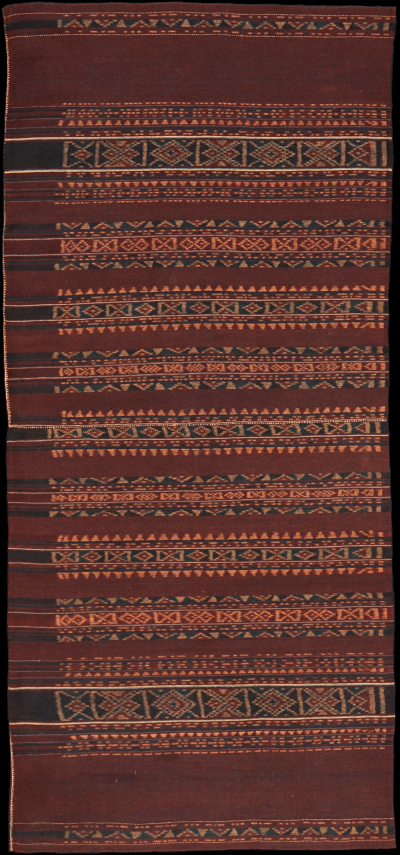| |
 
 | | | |
115 Solor Archipelago, Lembata
Kewatek (sarong)  
| | Locale: | Ili Api. Lamaholot people. | | Period: | 19th or early 20th c. | | Yarn: | Cotton, hand-spun, coarse | | Technique: | Warp ikat | | Panels: | 2 | | Size: | 68.5 x 151 cm (2' 2" x 4' 11") LW: 2.20 | | Design: | Kewatek nai rua, two panel sarong, decorated with nine bands of varying width with geometrical patterns in aubergine, morinda red, ecru and sand-colour. Stripes, two threads wide, in soft pink and light blue. Nine, rather than the more common seven, ikated bands plus two stripes at the extremities. A very similar cloth is identified as watek ohing by Barnes. This may be an additional name for the type, which refers to an aspect other than the number of panels. The motifs in the wider bands in olden days probably were the prerogative of a certain descent line. | | Comment: | Early piece of rare quality. Excellent, tight weaving, on a par with the best cognates. Beautiful saturated tones. All vegetable dyes. The straight vertical alignment is a prerequisite for its use as bridewealth between families of standing. | | Background: | Chapters on Solor Archipelago and Lembata. | | Exhibited: | Museu do Oriente, Lisbon, 2014/15.
Hong Kong University Museum and Art Gallery, 2017. | | Published: |
Woven Languages, 2014.
Ikat Textiles of the Indonesian Archipelago, 2018.
| | Compare: | 131 047 119 048 126 | | Sources: | Very similar to two panel sarong identified as watek ohing in Barnes and Hunt Kahlenberg, Five centuries of Indonesian Textiles, p. 347; to 19th C. kewatek in Granucci, Art of the Lesser Sundas, Fig. 109; as well as to PC 131, but with clearer, tighter ikat. | | |

©Peter ten Hoopen, 2025
All rights reserved.
|
|


